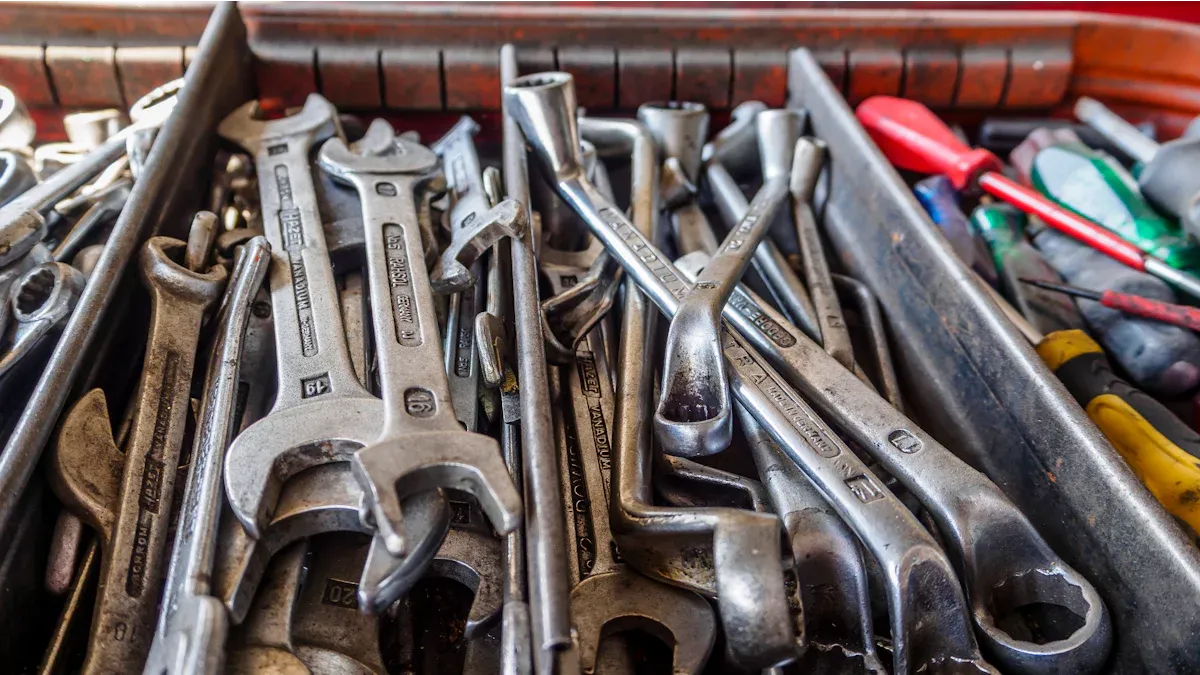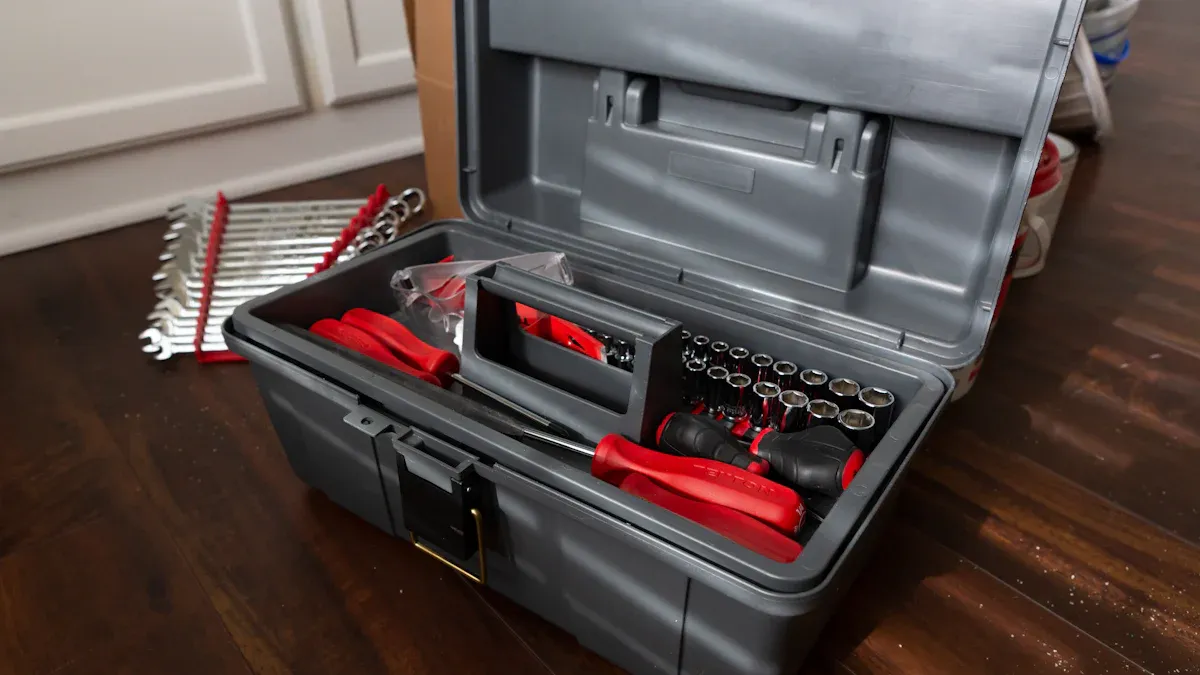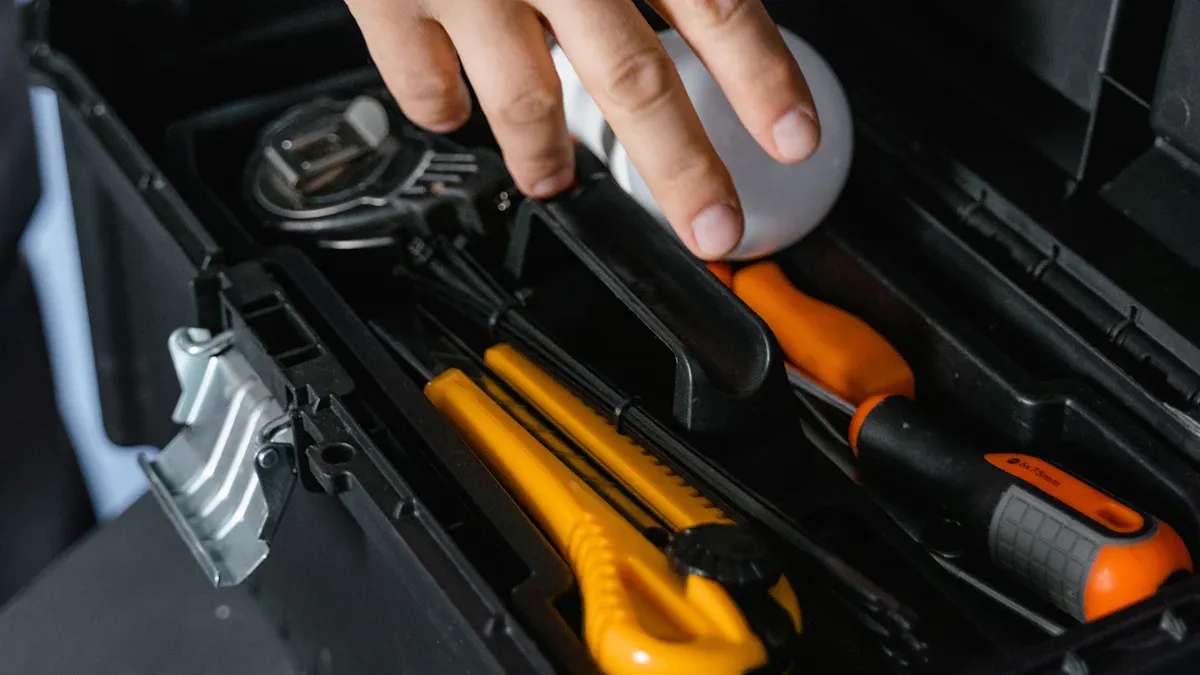Using Flashlights for Home Repairs: Why You Need One in Your Toolbox

Have you ever tried fixing something at home only to realize you can’t see what you’re doing? A flashlight solves that problem instantly. It’s your go-to tool for dark spaces, emergencies, or power outages. A reliable flashlight ensures you’re always ready to tackle repairs with confidence and ease.
Key Takeaways
A flashlight is important for seeing in dark or small spaces. It helps you notice all the details during home repairs.
When the power goes out, a good flashlight keeps you safe. It helps you fix things easily. Keep one in your toolbox and another nearby.
Pick a strong, water-resistant flashlight with adjustable brightness. This makes it useful for many tasks around the house.
Why a Flashlight is Essential for Home Repairs

Working in Dark or Tight Spaces
Have you ever tried fixing a leaky pipe under the sink or checking a fuse box in a dim corner? These tasks can feel impossible without proper lighting. A flashlight makes all the difference. It helps you see clearly in cramped or poorly lit areas. A tactical flashlight, with its compact design and powerful beam, is perfect for these situations. You can even find models with adjustable brightness, so you get just the right amount of light for the job. Whether you're repairing a cabinet hinge or inspecting a crawl space, a good flashlight ensures you don’t miss any details.
Handling Repairs During Power Outages
Power outages can strike at the worst times. Imagine trying to fix a tripped breaker or secure a window during a storm without light. A reliable flashlight is your best friend in these moments. Tactical flashlights are especially useful because they’re durable and often water-resistant, making them ideal for emergencies. Some even come with rechargeable batteries, so you’re always prepared. Keep one in your toolbox and another in an easy-to-reach spot in your home. That way, you’ll never be left in the dark when repairs can’t wait.
Ensuring Safety in Hazardous Conditions
Certain repair tasks come with risks, especially in hazardous environments. Using a water-resistant flashlight or a tactical flashlight designed for safety can help you avoid accidents.
Intrinsically safe flashlights are designed to prevent sparks and high temperatures that could ignite flammable materials, thus enhancing safety in hazardous environments.
Here’s a quick look at some hazardous conditions where a flashlight is crucial:
Class | Type of Hazardous Material |
|---|---|
Class I | Flammable gases, vapors, or liquids. Examples include petroleum refineries and gasoline storage areas. |
Class II | Combustible dusts. Examples include grain elevators and coal preparation plants. |
Class III | Ignitable fibers and flyings. Examples include textile mills and sawdust-producing plants. |
A tactical flashlight not only provides light but also keeps you safe in these challenging situations. It’s a small tool with a big impact.
Features to Look for in a Flashlight for Home Repairs

Brightness and Adjustable Settings
When choosing a flashlight for your home repairs, brightness is key. You want a flashlight that provides enough light to illuminate your workspace clearly. Look for models with adjustable settings. These let you switch between high and low brightness levels depending on the task. For instance, a tactical flashlight often offers multiple modes, including a focused beam for detailed work or a wider beam for larger areas. This flexibility ensures you always have the right amount of light, whether you're fixing a leaky pipe or inspecting your attic.
Durability and Water Resistance
A good flashlight should be tough enough to handle the wear and tear of home repairs. Accidental drops or exposure to moisture shouldn't render it useless. Many tactical flashlights are built with durable materials like aluminum, making them resistant to impact. Opt for a water-resistant flashlight or even a waterproof one if you often work in damp environments. These features ensure your flashlight remains reliable, even in challenging conditions.
Portability and Compact Design
You don’t want a bulky flashlight taking up too much space in your toolbox. A compact design makes it easy to carry and store. Tactical flashlights are a great choice here. They’re lightweight and small enough to fit in your pocket, yet powerful enough to handle most repair tasks. Portability means you can easily grab your flashlight and get to work without fumbling around.
Long Battery Life and Rechargeable Options
A flashlight with long battery life saves you from the frustration of frequent replacements. Rechargeable options are even better. They’re eco-friendly and cost-effective in the long run. Common rechargeable batteries include NiMH and Li-ion. Here’s a quick comparison to help you decide:
Battery Type | Voltage Range | Capacity Range | Common Sizes |
|---|---|---|---|
NiMH | 1.2V | AA: 800mAh - 2800mAh | AA, AAA, C, D |
AAA: 1000mAh - 1500mAh | |||
C: 3000mAh - 5000mAh | |||
D: 6000mAh - 10000mAh | |||
Li-ion | 1.5V - 3.7V | 18650: 2000mAh - 3400mAh | 18650, 16340, 14500 |
16340: Varies | |||
14500: Varies |
A tactical flashlight with rechargeable batteries ensures you’re always ready for your next repair project. It’s a smart investment for any homeowner.
Practical Tips for Adding a Flashlight to Your Toolbox
Selecting the Right Flashlight for Your Needs
Choosing the perfect flashlight for your toolbox depends on your specific repair tasks. Start by thinking about how you’ll use it. Do you need a flashlight for tight spaces, outdoor repairs, or general home fixes? Each situation might call for a different type. For example:
Brightness: Check the lumens rating. A higher number means a brighter light, which is great for detailed work.
Beam Distance: If you’re working in large spaces, a flashlight with a long beam distance is essential.
Durability: Look for water-resistant or waterproof models that can handle tough conditions.
Battery Life: A flashlight with long-lasting or rechargeable batteries ensures you won’t run out of power mid-task.
Size and Weight: A compact, lightweight tactical flashlight is easy to carry and store.
Some popular models include the Fenix HM71R, which offers adjustable brightness and hands-free use, and the Fenix WF25RM, with an impressive 3000 lumens and a beam that reaches over 1200 feet. These options combine power and portability, making them ideal for home repairs.
Storing Your Flashlight for Quick Access
Keeping your flashlight in the right spot ensures it’s always ready when you need it. Store it in a dry, cool place to protect it from damage. Regularly check the batteries, especially if you don’t use the flashlight often. Replace them as needed to avoid leaks or dead batteries during emergencies. Inspect the lens and body for cracks or wear to catch issues early. A tactical flashlight with a magnetic base can be mounted on a metal surface for easy access, saving you time during repairs.
Maximizing the Benefits of a Flashlight in Repairs
To get the most out of your flashlight, use it strategically. For hands-free lighting, choose a headlamp or a flashlight with a magnetic base. This frees up both hands for your tools. Adjust the brightness settings to match your task. A dimmer light works well for close-up repairs, while a brighter beam is better for larger areas. If you’re working in damp conditions, a water-resistant or waterproof flashlight ensures reliability. A tactical flashlight with multiple modes can adapt to various repair needs, making it a versatile addition to your toolbox.
A flashlight is more than just a tool; it’s your partner for tackling repairs around your home. Whether you’re working in tight spaces or dealing with emergencies, a water-resistant or waterproof flashlight ensures you’re ready. Add one to your toolbox today and handle every repair with confidence and ease.
FAQ
What type of flashlight is best for home repairs?
Choose a compact, durable flashlight with adjustable brightness. A tactical flashlight or headlamp works great for tight spaces and hands-free tasks.
How do I maintain my flashlight?
Store it in a dry place. Check batteries regularly to avoid leaks. Clean the lens and body with a soft cloth to keep it in top shape.
Can I use a rechargeable flashlight for emergencies?
Absolutely! Rechargeable flashlights are reliable and eco-friendly. Keep them charged and ready for power outages or urgent repairs.
💡 Tip: Always have a backup flashlight with fresh batteries for added peace of mind.
See Also
Essential LED Flashlights Every Home Should Have
Selecting The Ideal Emergency Flashlight For Homeowners
Why Hunting Flashlights Are Crucial For Outdoor Adventures
